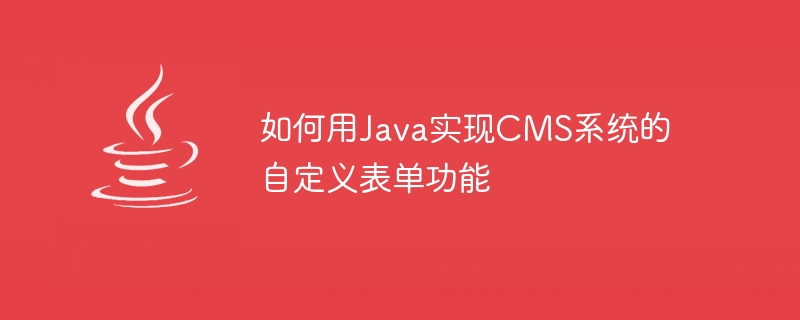How to use Java to implement the custom form function of CMS system

How to use Java to implement the custom form function of the CMS system
Abstract: With the development of information technology, content management systems (CMS) have become an important part of website construction. component. The custom form function is an important function in the CMS system, which can realize data collection and display on user-defined pages. This article will introduce how to use Java to write code to implement the custom form function of the CMS system, and provide relevant code examples for readers' reference.
1. Overview
The custom form function is an important part of the CMS system. It can help website administrators and users easily customize the data collection and display methods of the page. In traditional CMS systems, front-end technologies such as HTML and JavaScript are usually used to implement custom form functions. This article will introduce how to use Java to write back-end code to implement the custom form function of the CMS system, providing a more flexible and scalable solution.
2. Implementation steps
- Database design
First, you need to design the database table structure to store form data. Usually, you can create two tables, one is used to store form information, including fields such as form name, form description, etc.; the other table is used to store form field information, including fields such as field name, field type, etc.
First, create the form information table:
CREATE TABLE form (
id INT PRIMARY KEY AUTO_INCREMENT, name VARCHAR(255), description TEXT
);
Then, create the form field information table:
CREATE TABLE form_field (
id INT PRIMARY KEY AUTO_INCREMENT, form_id INT, name VARCHAR(255), type VARCHAR(255), FOREIGN KEY (form_id) REFERENCES form(id)
);
- Backend code implementation
Next, customize it by writing Java backend code Form function.
First, create a form entity class:
public class Form {
private int id; private String name; private String description; // 省略Getter和Setter方法
}
Then, create a form field entity class:
public class FormField {
private int id; private int formId; private String name; private String type; // 省略Getter和Setter方法
}
Next, create a DAO class for operating the database, such as FormDAO and FormFieldDAO, to implement the form information table and form field information table Add, delete, modify and check operations.
In the FormDAO class, you can implement the following methods to operate the form information:
public Form getFormById(int id) {
// 根据id查询表单信息
}
public List

Hot AI Tools

Undresser.AI Undress
AI-powered app for creating realistic nude photos

AI Clothes Remover
Online AI tool for removing clothes from photos.

Undress AI Tool
Undress images for free

Clothoff.io
AI clothes remover

AI Hentai Generator
Generate AI Hentai for free.

Hot Article

Hot Tools

Notepad++7.3.1
Easy-to-use and free code editor

SublimeText3 Chinese version
Chinese version, very easy to use

Zend Studio 13.0.1
Powerful PHP integrated development environment

Dreamweaver CS6
Visual web development tools

SublimeText3 Mac version
God-level code editing software (SublimeText3)

Hot Topics
 1377
1377
 52
52
 Perfect Number in Java
Aug 30, 2024 pm 04:28 PM
Perfect Number in Java
Aug 30, 2024 pm 04:28 PM
Guide to Perfect Number in Java. Here we discuss the Definition, How to check Perfect number in Java?, examples with code implementation.
 Random Number Generator in Java
Aug 30, 2024 pm 04:27 PM
Random Number Generator in Java
Aug 30, 2024 pm 04:27 PM
Guide to Random Number Generator in Java. Here we discuss Functions in Java with examples and two different Generators with ther examples.
 Weka in Java
Aug 30, 2024 pm 04:28 PM
Weka in Java
Aug 30, 2024 pm 04:28 PM
Guide to Weka in Java. Here we discuss the Introduction, how to use weka java, the type of platform, and advantages with examples.
 Smith Number in Java
Aug 30, 2024 pm 04:28 PM
Smith Number in Java
Aug 30, 2024 pm 04:28 PM
Guide to Smith Number in Java. Here we discuss the Definition, How to check smith number in Java? example with code implementation.
 Java Spring Interview Questions
Aug 30, 2024 pm 04:29 PM
Java Spring Interview Questions
Aug 30, 2024 pm 04:29 PM
In this article, we have kept the most asked Java Spring Interview Questions with their detailed answers. So that you can crack the interview.
 Break or return from Java 8 stream forEach?
Feb 07, 2025 pm 12:09 PM
Break or return from Java 8 stream forEach?
Feb 07, 2025 pm 12:09 PM
Java 8 introduces the Stream API, providing a powerful and expressive way to process data collections. However, a common question when using Stream is: How to break or return from a forEach operation? Traditional loops allow for early interruption or return, but Stream's forEach method does not directly support this method. This article will explain the reasons and explore alternative methods for implementing premature termination in Stream processing systems. Further reading: Java Stream API improvements Understand Stream forEach The forEach method is a terminal operation that performs one operation on each element in the Stream. Its design intention is
 TimeStamp to Date in Java
Aug 30, 2024 pm 04:28 PM
TimeStamp to Date in Java
Aug 30, 2024 pm 04:28 PM
Guide to TimeStamp to Date in Java. Here we also discuss the introduction and how to convert timestamp to date in java along with examples.
 Create the Future: Java Programming for Absolute Beginners
Oct 13, 2024 pm 01:32 PM
Create the Future: Java Programming for Absolute Beginners
Oct 13, 2024 pm 01:32 PM
Java is a popular programming language that can be learned by both beginners and experienced developers. This tutorial starts with basic concepts and progresses through advanced topics. After installing the Java Development Kit, you can practice programming by creating a simple "Hello, World!" program. After you understand the code, use the command prompt to compile and run the program, and "Hello, World!" will be output on the console. Learning Java starts your programming journey, and as your mastery deepens, you can create more complex applications.




